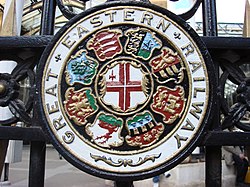
Back Great Eastern Railway Catalan Great Eastern Railway Danish Great Eastern Railway German Great Eastern Railway French Great Eastern Railway NB Great Eastern Railway Portuguese Great Eastern Railway SIMPLE 大东部铁路 Chinese
 | |
 1920 map of the railway | |
| Overview | |
|---|---|
| Dates of operation | 1862–1922 |
| Predecessor | Eastern Counties Railway Eastern Union Railway and others |
| Successor | London and North Eastern Railway |
| Technical | |
| Track gauge | 4 ft 8+1⁄2 in (1,435 mm) standard gauge |
| Length | 1,191 miles 23 chains (1,917.2 km) (1919)[1] |
| Track length | 2,631 miles 24 chains (4,234.7 km) (1919)[1] |
The Great Eastern Railway (GER) was a pre-grouping British railway company, whose main line linked London Liverpool Street to Norwich and which had other lines through East Anglia. The company was grouped into the London and North Eastern Railway in 1923.
Formed in 1862 after the amalgamation of the Eastern Counties Railway and several other smaller railway companies the GER served Cambridge, Chelmsford, Colchester, Great Yarmouth, Ipswich, King's Lynn, Lowestoft, Norwich, Southend-on-Sea (opened by the GER in 1889), and East Anglian seaside resorts such as Hunstanton (whose prosperity was largely a result of the GER's line being built) and Cromer.[2] It also served a suburban area, including Enfield, Chingford, Loughton and Ilford. This suburban network was, in the early 20th century, the busiest steam-hauled commuter system in the world.
The majority of the Great Eastern's locomotives and rolling stock were built at Stratford Works, part of which was on the site of today's Stratford International station and the rest was adjacent to Stratford Regional station. The GER owned 1,200 miles (1,931 km) of line and had a near-monopoly in East Anglia until the opening of the Midland and Great Northern Joint Railway in 1893 although there were a number of minor lines, such as the Mid-Suffolk Light Railway that stayed resolutely independent until after the grouping in 1923.
- ^ a b The Railway Year Book for 1920. London: The Railway Publishing Company Limited. 1920. p. 129.
- ^ "GER map 1923". Great Eastern Railway Society. Great Eastern Railway. Retrieved 21 August 2016.